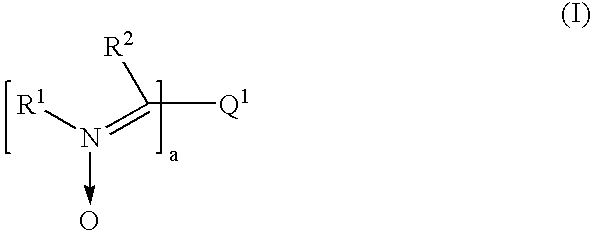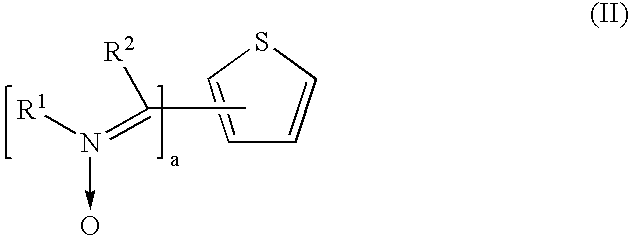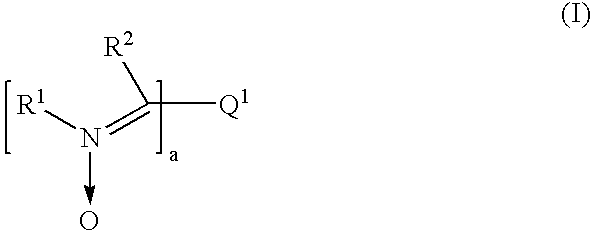Compositions and methods for storing holographic data
a technology of holographic data and compositions, applied in the field of methods for storing holographic data, can solve the problems of fading, high cost of linbo, and relatively poor efficiency, and achieves the effects of reducing the number of holographic data
- Summary
- Abstract
- Description
- Claims
- Application Information
AI Technical Summary
Benefits of technology
Problems solved by technology
Method used
Image
Examples
example 1
Preparation Of 2,5-Bis (N-(4-Ethoxycarbonylphenyl) Imino-N-Oxide) Thiophene Ex. 1
[0078]
[0079]Carbethoxyphenylhydroxylamine 1 (3.36 gm, 18.5 mmol) was mixed with 2,5 thiophenedicarboxaldehyde (0.65 gm, 4.64 mmol) in glacial acetic acid (70 ml) and stirred at room temperature for 20 hours. The reaction mixture was poured into water (200 ml) and the product was filtered. The filtered product was washed with water and dried at 60° C. to give 2.0 gm orange colored crude product. The product was purified by boiling the crude product in acetonitrile followed by filtration gave 1.0 gm (˜46.0% yield) 2,5-bis (N-(4-ethoxycarbonylphenyl) imino-N-oxide) thiophene (HPLC purity: 94.3%; DSC: 247° C.).
Preparation Of 4-Nitro-Benzoic Acid 2-Ethyl-Hexyl Ester 2
[0080]
[0081]To the 250 ml 3-necked flask was added 10.0 gm 2-ethyl 1-hexanol, 100 ml dichloromethane, and 6.0 gm pyridine and the contents were stirred for 10 minutes. To this mixture, 14.2 gm 4-nitro benzoyl chloride was added slowly and stirre...
example 2
Preparation Of 2, 5-Thiophene Bis-2-Ethylhexylesterphenyl Dinitrone (Ex.2)
[0084]
[0085]To a 250 ml 3-necked flask was added 0.5 gm 2,5-thiophenedicarboxaldehyde, 30 ml acetic acid, 5.6 gm 2-ethylhexylesterphenyl hydroxylamine 3 and stirred for 20 hrs at room temperature. To the reaction mixture, 100 ml water was added and the mixture was filtered. The filtered product was washed with water and dried. A yield of about 1.6 gm of 2, 5-thiophene bis-2-ethylhexylesterphenyl dinitrone of Ex.2 was obtained with a HPLC purity of 98% (DSC: 205° C.).
[0086]Structures of the various nitrone and dinitrone dyes studied are gathered in Table 1 together with data for diffraction efficiency and quantum efficiency measured for molded disks containing the dye. In addition data on nitrone stability is also presented.
TABLE 1DiffractionQuantumEfficiencyEfficiencyDecompositionat 532 nmAt 532TempratureDye Structurewrite / readnm(° C.)CEx. 1—0.0 110CEx. 20.090.05185CEx. 3——80 Ex. 30.420.18247 Ex. 4——251 Ex....
PUM
 Login to View More
Login to View More Abstract
Description
Claims
Application Information
 Login to View More
Login to View More - R&D
- Intellectual Property
- Life Sciences
- Materials
- Tech Scout
- Unparalleled Data Quality
- Higher Quality Content
- 60% Fewer Hallucinations
Browse by: Latest US Patents, China's latest patents, Technical Efficacy Thesaurus, Application Domain, Technology Topic, Popular Technical Reports.
© 2025 PatSnap. All rights reserved.Legal|Privacy policy|Modern Slavery Act Transparency Statement|Sitemap|About US| Contact US: help@patsnap.com



